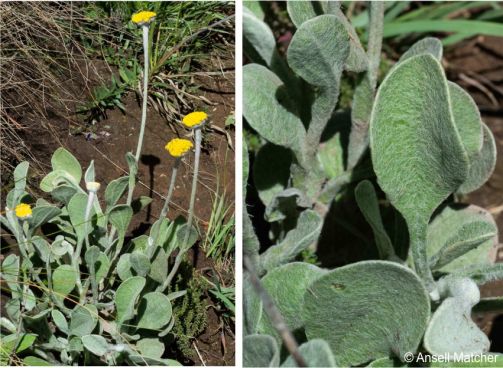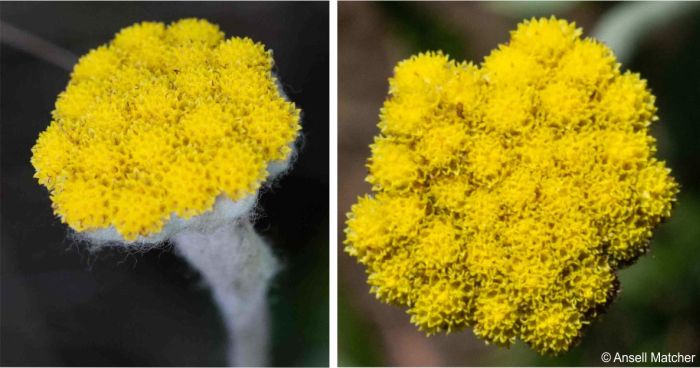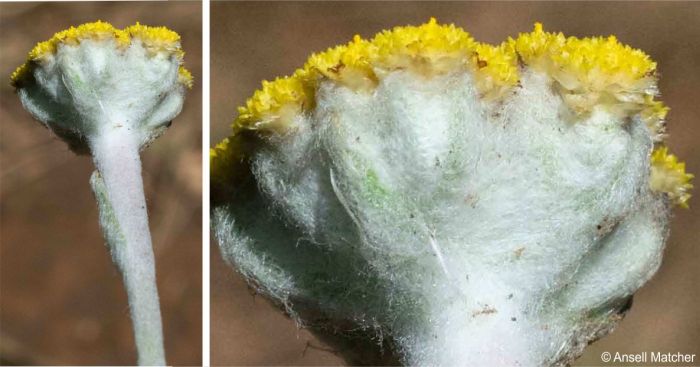Helichrysum drakensbergense
Helichrysum drakensbergense Killick
Family: Asteraceae
Common names: Drakensberg everlasting (Eng.)
Introduction
The Drakensberg everlasting is a small perennial herb with woolly grey leaves and compact flat inflorescences of yellow flowers on long stalks covered in white wool. It grows in high altitude grassland in a limited area of the KwaZulu-Natal Drakensberg.

Description
Description
Helichrysum drakensbergense is a bushy perennial herb about 400 mm tall, the stem is often reclining on the ground when roots can be formed, the branches are erect, grey-woolly and leafy in the lower half. The leaves are up to 90 x 30 mm, spatulate (spoon shaped), having a broad rounded tip and petiole-like base expanded below and half clasping the stem, grey-woolly on both surfaces.

Flower heads are homogamous (contain flowers that are all the same), campanulate (bell-shaped), about 6 x 4 mm and are surrounded by a whorl of straw-coloured, glossy bracts in 3 series and loosely overlapping. Flowers are yellow and a head contains 15-28 flowers. Many heads are clustered together in a tight, flattish inflorescence up to 25 mm in diameter, at the tip of a long grey-woolly stalk. Flowering is in early summer, from November to January.

Conservation Status
Status
Helichrysum drakensbergense is assessed as Rare on the Red list of South African plants. This species occurs in grassland at the higher altitudes of the Drakensberg and it is not threatened.
Distribution and habitat
Distribution description
Helichrysum drakensbergense is a Drakensberg and South African endemic, it is found in a very limited area of the KwaZulu-Natal Drakensberg at Garden Castle Forest Reserve and Sani Pass in the Underberg district and on the northern side of Cleft Peak in the Bergville district. It forms large but often highly localized colonies on grassy slopes or in scrub, between 1 525 and 2 740 m above sea level.
Derivation of name and historical aspects
History
The name Helichrysum, is derived from the Greek word helios meaning ‘sun’ and chrysos meaning ‘gold’, referring to the usually bright yellow flowers of plants in the genus. The specific epiphet drakensbergense mean ‘from the Drakensberg’, referring to its habitat.
The genus Helichrysum belongs to one of the largest and best known families, Asteraceae, the daisy family, that contains about 1 530 genera worldwide and 22 800 species. About 240 Helichrysum species are indigenous to South Africa. The most closely related species to Helichrysum drakensbergense is H. odoratissimum, which can be distinguished by its leaves, compound and simple inflorescence and peduncle. Most species of Helichrysum are used as traditional medicine in South Africa and are known for their interesting form variation.

Ecology
Ecology
The woolly grey hairs covering the plant and narrow leaf shape are adaptations to help the plant prevent water loss, allowing the plants to survive on little water. The flowers of Helichrysum drakensbergense attract bees and other insects, which pollinate them. The seeds are light in weight, with hairs that may serve as a wing during dispersal by wind. The tiny seeds may be blown or washed away from the parent and influence population size. This species of Helichrysum acts as a good soil binder and prevents erosion.
Uses
Use
Many species of Helichrysum are used medicinally for various purposes such as the treatment of many ailments including fatigue, backache, bladder infections, stress, influenza, gynaecological disorders and cardiac problems. The species with strongly aromatic leaves can be used to keep insects away and are burned like incense. The greyish to white, woolly leaves of many Helichrysum species are often used to dress wounds to prevent infection.
Helichrysum drakenbergense is not known to be used in traditional medicine, and being a rare species from high in the mountains, it is probably seldom harvested for medicinal purposes.

Growing Helichrysum drakensbergense
Grow
This species is not seen often in cultivation. It can be propagated by cuttings and seeds. Take softwood cuttings in spring (September) and plant in a well-drained rooting medium, use a rooting hormone to encourage root growth. Place the cutting in a warm environment with light but not direct sun and keep moist. Sow seeds in spring or early summer in well-drained sandy or loamy soil with acid to neutral pH balance.
Helichrysum drakensbergense prefers sunny to semi-shaded locations in well-drained, composted, sandy or loamy soil with an acidic to neutral pH balance. They are ideal for rockeries, raised beds, mixed shrubberies, and can also be used as a groundcover, their wonderful grey foliage, making them ideal to use as ornamentals.
References
- Asteraceae Fact Sheets, Helichrysum drakensbergense. https://keys.lucidcentral.org/keys/v3/helichrysum/key/Helichrysum/Media/Html/Helichrysum_drakensbergense.htm. Accessed on 2023.09.20.
- Brand, R., Scott-Shaw, C.R. & O’Connor, T.G. 2019. The alpine flora on inselberg summits in the Maloti-Drakensberg Park, KwaZulu-Natal, South Africa. Bothalia 49(1).
- Carbutt, C. 2006. The endemic and near-endemic angiosperm of Drakensberg Alpine Centre. South African Journal of Botany 72(1):105-132.
- Kamundi, D.A. & Victor, J.E. 2009. Helichrysum drakensbergense Killick. National Assessment: Red List of South African Plants version 2020.1. Accessed on 2023/09/25.
- Lourens, A.C.U., Viljoen, A.M. & van Heerden F.R. 2003. South African Helichrysum species: A review of the traditional uses, biological activity and phytochemistry. Journal of Ethnopharmacology 119: 630–652.
- Manson, A. 2019. Observation of Helichrysum drakensbergense, Drakensberg, KZN. https://www.inaturalist.org/observations/36804538.
- Matcher, A. 2020. Observation of Helichrysum drakensbergense, Mkhomazi Wilderness Area, KZN. https://www.inaturalist.org/observations/66911060.
- Pooley, E. 2003. Mountain flowers, a field guide to the flora of the Drakensberg and Lesotho. Natal Flora Publications Trust, Durban.
Credits
Mashudu Tshitereke
KwaZulu Natal National Botanical Garden
October 2023
Acknowledgements: images by Alan Manson and Ansell Matcher from their observations posted on iNaturalist.
Plant Attributes:
Plant Type: Perennial
SA Distribution: KwaZulu-Natal
Soil type: Sandy, Loam
Flowering season: Early Summer
PH: Acid, Neutral
Flower colour: Yellow
Aspect: Full Sun, Morning Sun (Semi Shade), Afternoon Sun (Semi Shade)
Gardening skill: Average
Special Features:
Horticultural zones








Rate this article
Article well written and informative
Rate this plant
Is this an interesting plant?
Login to add your Comment
Back to topNot registered yet? Click here to register.